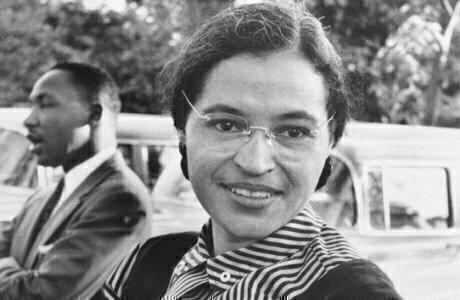On the occasion of Rosa Park’s birthday, Constitution Daily looks at her journey from a childhood in the segregated south to her enduring status as a civil rights icon.
On February 4, 1913, Rosa Louise McCauley was born in Tuskegee, Alabama. Her parents separated during the early part of her life, and Rosa and her mother lived her grandparents for a time, who were former slaves.
Rosa met and married Raymond Parks in 1932 at the age of 19. Raymond was a barber and an active member of the National Association for the Advancement of Colored People (or NAACP). About a decade later, Rosa Parks joined NAACP’s Montgomery, Alabama chapter, and she later served as the secretary for that chapter.
Parks had attended a public meeting of concerned citizens in late November 1955 after the murder of Black teenager Emmett Till. Parks also had attended a meeting in August 1955 with a new preacher in town, Martin Luther King, who spoke about the importance of the Supreme Court’s Brown v. Board decision about the legality of segregation.
The NAACP also had been looking for a test case about segregation on Montgomery’s bus system, but a first potential test case wasn’t feasible when its prospective plaintiff was found to be pregnant.
But then, Parks was arrested on December 1, 1955, after she refused to give up her seat on a crowded bus to a white passenger.
Contrary to some reports, Parks wasn’t physically tired and was able to leave her seat. She refused, on principle, to surrender her seat because of her race, which was the law in Montgomery at the time.
Parks was briefly jailed and paid a fine. But she was a long-time member of the NAACP and a highly respected person in her community, so the NAACP realized it had the right person to work with, as it battled against the system of segregation in Montgomery.
It also worked with another group of local leaders to stage a one-day boycott of passenger buses, when Parks went to court. The group expanded to include other people, chose a name—the Montgomery Improvement Association, or MIA—and planned an extended boycott.
The MIA picked the 26-year-old King, who was a little-known pastor who had recently arrived in Montgomery, to lead the boycott.
The combination of the MIA, King, Parks, Edgar Nixon (the local NAACP chapter leader) and a united African American community made the boycott a success. About 75 percent of the public transportation customers in Montgomery were Black persons, and they remained united for more than a year, as the boycott crippled revenues for the bus line. Parks lost her job and King’s home was attacked, but the movement kept the boycott in place for 381 days.
At the same time, the segregation fight was making its way to the Supreme Court. On November 13, 1956, the Supreme Court ruled in the case of Browder v. Gayle, agreeing with a 2-1 district court decision that segregation on buses operating within Alabama’s boundaries was illegal, because segregation deprived people of equal protection of the law under the 14th Amendment.
The legal team that had pursued the case for the NAACP included Thurgood Marshall, a future Supreme Court Justice. In the meantime, the team had decided that Parks’s case would get tied up in the state court system and instead had filed a separate suit on the behalf of four other women.
After the boycott ended, Parks had become a civil rights icon, and she and her husband Raymond moved to Virginia after experiencing a series of hardships and then moved to Detroit.
Parks was disillusioned by discrimination in Detroit, but she befriended a young politician there, John Conyers. Parks worked for Conyers after his election to the House of Representatives from 1965 to 1988, and she remained active in the civil rights community, and she wrote several books.
When she passed away at the age of 92 in 2005, Congress voted to have Parks honored by having her coffin at the Capitol Rotunda for public viewing.
At the time, she was only the 30th person accorded that honor. She was the first woman to receive the honor, and her coffin sat on the catafalque built for the coffin of Abraham Lincoln.








